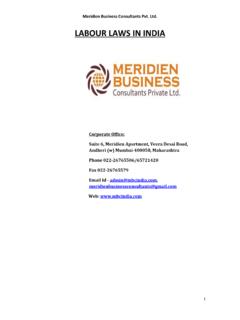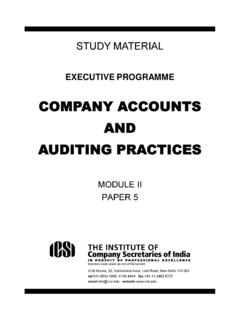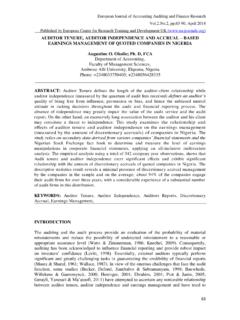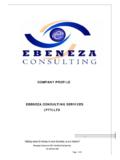Transcription of MANUAL ON INTERNAL AUDITING - mbcindia.com
1 1 MANUAL ON INTERNAL AUDITING S. Adukia +91 93230 61049 INDEX Section 1: Foundation of INTERNAL AUDITING What is INTERNAL AUDITING ? History and background Purpose of INTERNAL AUDITING Scope of INTERNAL AUDITING Role of auditors Organisational Independence and Objectivity Professionalism Section 2: Types of INTERNAL AUDITING Financial Audits. Operational Audits. Grant Audits Project Audits Information System Audit Compliance Audits Investigative Audit Due diligence 2 Section 3: Managing INTERNAL Audit Organising the department Audit Staff Managing the Audit Audit Planning Risk Management Engagement memorandum Section 4: Audit programme and procedures Field survey Audit programme Audit procedures Evaluation of INTERNAL control system Audit sampling Audit Tests Specimen letters Section 5.
2 CAATs Definition Need Techniques Commonly used Audit Software Section 6 : Audit Work papers Importance Functions Organisation i. Document organisation ii. CAAT work papers 3 Review of work papers Retention and Custody Section 7: Audit Reports and Communication Purpose of Audit Report Types of Audit Report Form and content of audit report Style and Attributes Audit Reporting Cycle Evaluation and Follow up Specimen INTERNAL audit report Section 8 : Relationship Management INTERNAL Audit and Audit Committee Relationship with management Working with External Auditors Relationship with regulators Section 9.
3 Overview of Standards in INTERNAL Audit Standards on INTERNAL Audit (SIA) issued by ICAI INTERNAL Audit Standards issued by IIA 4 Section 1. Foundation of INTERNAL AUDITING What is INTERNAL AUDITING ? History and background Purpose of INTERNAL AUDITING Scope of INTERNAL AUDITING Role of auditors Organisational Independence and Objectivity Professionalism What is INTERNAL AUDITING ? INTERNAL AUDITING is an independent, objective assurance and consulting activity designed to add value and improve an organisation s operations.
4 It helps an organisation accomplish its objectives by bringing a systematic, disciplined approach to evaluate and improve the effectiveness of risk management, control and governance processes. INTERNAL Auditor can make: an objective assessment of operations and share ideas for best practices. provide guidance for improving controls, processes and procedures, performance, and risk management. Thus, INTERNAL audit activity can play an important role and support the board and management in fulfilling an essential component of their governance mechanisms.
5 The INTERNAL auditor furnishes analysis, appraisals, recommendations, counsel and information concerning the activities reviewed. The INTERNAL auditor can suggest ways 5 for reducing costs, enhancing revenues, and improving profits. A It is worth remembering that INTERNAL audit works in partnership with management and provides the board, the audit committee and executive management assurance that risks are held at bay and the organization s corporate governance is strong and effective. They work in the same team and want the organisation to be and remain successful.
6 History and background In 1930s, growth and expansion made it increasingly difficult for organizations to maintain control and operational efficiency. The World War further expanded organizations responsibilities for scheduling, managing with limited materials and labourers, complying with government regulations, and an increased emphasis on cost finding. It was difficult for management to observe all the operating areas or be in touch with everybody. Then, special staff was appointed to report on happenings in the company who later came to be known as INTERNAL Auditors.
7 The INTERNAL AUDITING function varied greatly between organisations and a number of INTERNAL auditors pushed vigorously for greater understanding and recognition of the INTERNAL AUDITING function. One such person was John B. Thurston, head of the INTERNAL AUDITING function at the North American utility company. He is credited with being the person most responsible for the creation of The Institute. He was joined by Robert B. Milne, general auditor of the Columbia Engineering Corporation, and Victor Z. Brink, a former auditor and Columbia University educator who authored the first major book on INTERNAL AUDITING .
8 They gathered friends and associates from the utilities industries, 6 public accounting firms, and other industries, 25 of whom agreed to participate in forming a new organization for INTERNAL auditors. On November 17, The IIA s Certificate of Incorporation was filed which officially established The Institute of INTERNAL Auditors name; recognized The Institute as a membership corporation; and identified corporation s specific purposes Purpose of INTERNAL AUDITING It s the responsibility of the Board to ensure that risks are managed and controlled.
9 This task is delegated to the executive management which Determines the risk appetite of the organisation Establishes the risk management framework Identifies potential threats and assesses risks Decides on response to risks like implementation of control monitors and coordinates the risk management processes and the outcomes, provides assurance on the effectiveness of risk management processes This assurance from the management is fundamental. There is a need for additional assurance from a different source. INTERNAL audit can be the key source providing objective assurance that all the significant risks have been identified, risk management process is working effectively and efficiently, risks are being reported and controls are effective.
10 As part of this work, the INTERNAL audit activity will provide advice, coaching and facilitation services to assist executive management in carrying out their responsibilities. Scope of INTERNAL AUDITING 7 The external auditors have to express an opinion on accuracy and fairness of financial information. The scope of INTERNAL audit is much wider than statutory/external audit. It should ideally cover all the organisation s activities. They include: Financial audit accuracy, completeness and fairness of financial statements Operational audit- effectiveness and efficiency of operations Safeguarding of assets Review of projects Management audit Fraud detection- developing fraud exposures for every audit and detecting red flags Review of effectiveness of INTERNAL control Compliance with laws, regulations.





